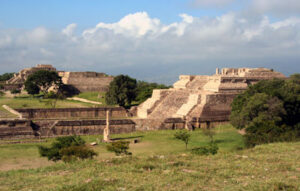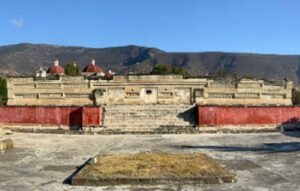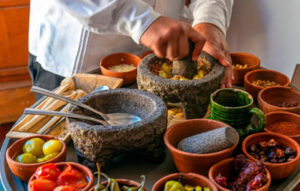
Boutique Hotel in Oaxaca
Places to visit in Oaxaca
The Mexican province of Oaxaca is brimming with dazzling design, agave plants and the absolute most delightful food (and mezcal!) in the country. As you plan your excursion to this bright Mexican objective, we're breaking out the top things to see, the best things to eat, and some off in an unexpected direction exercises. You'll have no lack of activities in Oaxaca, and we're here to assist you with arranging an amazing excursion. Contact our front desk for more information.
MONTE ALBAN AND HANDICRAFTS ROUTE

Archaeological zone of Monte Albán
Monday to Sunday
10:00 a 16:00 hrs
It was one of the most important cities in Mesoamerica. It was founded in 500 BC on top of a mountain in the center of the Central Valleys of Oaxaca and functioned as the capital of the Zapotecs from the beginning of our era until 800 A.C.
Santa María Atzompa
Saturday & Sunday
9:00 a 15:00 hrs
It was one of the monumental complexes of Monte Albán. Its occupation goes from 650 to 900 AD. A peculiarity of this archaeological zone is the existence of three courts for the Ball Game very close to each other, one of them 45 meters long, which makes it the largest in the area, including Monte Albán.
San Martin Tilcajete
San Martín Tilcajete is the town where alebrijes are born, representations of imaginary animals carved in wood in a combination of bright colors. The meaning of alebrije comes from three words which are: Joy for its colors, Witch for mysticism and Embije which means to dye or paint something red. Although it is thought that the true alebrije was made of cardboard, in Oaxaca the technique has always been made of wood. Visit the renowned workshop of "Jacobo and María Ángeles".
Santo Tomás Jalieza
This picturesque town whose name means in Zapotec "below the church", where a wide variety of crafts are made, such as embroidery and weaving, which are offered to the public on market days, which is Friday. Its temple, built in honor of Santo Tomás, dating from the 17th century, is worth visiting. Inside there are good quality baroque style altarpieces.
San Antonino Castillo
Typical clothing is produced based on blankets adorned with silk thread embroidery.
In addition to these beautiful embroidered blouses or shirts, they are also dedicated to making calenda baskets or images dressed with immortal flowers.
San Bartolo Coyotepec
The black clay of Coyotepec immediately comes to mind when mentioning the pottery of Oaxaca. It is one of the most famous pottery towns in Mexico. It is also the largest in Oaxaca, with some 700 households actively producing.
The local pottery is unique, not only because of its black color, but also because of the fine body of the clay. The clay is so fine and well burned that it is useless for cooking. However, for centuries Coyotepecs pottery has been recognized as the best for containing liquids: pitchers for the well, watering pots, sinks, water containers and bottles for mezcal.
ROUTE TO
MITLA

Mitla Archaeological Zone
Wednesday to Saturday
10:00 a 15:00 hrs
The archaeological zone of Mitla is located in the northern portion of the Valley of Tlacolula. The monuments that can be visited here are distributed in five groups, four of which are very similar to each other, being formed by two quadrangular patios surrounded by large halls on each of their sides.
Dainzú
Wednesday to Sunday
10:00 a 16:00 hrs
Dainzú is a Zapotec settlement, located in the Tlacolula Valley. Although it is contemporary to Monte Albán, its foundation dates back to before the founding of the great city. For that time (7th to 5th century BC), it was contemporary with other sites settled in the Central Valleys of Oaxaca, such as San José Mogote.
Teotitlán del Valle
Teotitlán Del Valle is distinguished and characterized by its outstanding production of wool rugs that its inhabitants make from an ancestral tradition. It was one of the main Zapotec towns of pre-Hispanic Mexico, rich in traditions and customs that date back to before the Colony and that were modified when the Spaniards arrived. In the patron saint festivities, the dancers, with their large plumes, dance in the atrium of the church and fill the town with celebration on those days, in addition to the calenda that runs through the main streets of the town.
Palenque de mezcal "Macurichos"
Explore these mezcal producing territories of Oaxaca, meet the mezcal masters, visit the palenques and taste the distillate.Led by the young and brilliant maestro mezcalero Gonzalo Martinez, Mezcal Macurichos is dedicated to the protection of both the cultural tradition and the agricultural heritage of agave within the iconic mezcal production community of Santiago Matatlán. The family palenque was founded in 1963 by Rosalino Martinez Ruiz and his son Rafael Martinez Hernandez after a long history of previous generations working for or renting other palenques. Today, Gonzalo and his three brothers continue to distill at the same site their grandfather and father established six decades ago.
Tlacolula
The city is the main commercial center for the Tlacolula Valley area, and best known for its weekly open air market held on Sundays. This market is one of the oldest, largest and busiest in Oaxaca, mostly selling food and other necessities for the many rural people which come into town on this day to shop. The city is also home to a 16th-century Dominican church, whose chapel, the Capilla del Señor de Tlacolula, is known for its ornate baroque decoration and a crucifix to which have been ascribed many miracles.
San Marcos Tlapazola
San Marcos has long been a supplier of pottery to the Central Valleys and the Tlacolula market. Although there are about 240 potters in the town, they work sporadically. However, since the late 1980s the village potters have been experimenting with new forms, which has led to better sales and recognition for the village.
The traditional forms are pots, pichanchas, saucepans, pans, whisks and comales. Innovative potters also make pots, plates, teapots, gravy boats, piggy banks, and serving platters.
Restaurants

Casa Oaxaca
Monday to Sunday
13:00 to 23:00 hrs
Casa Oaxaca is a classic, a pioneer in the new signature Oaxacan cuisine, directed by Chef Alejandro Luis Olmedo. Modern Oaxacan dishes made with organic vegetables and free-range meats served on a lavish patio.
Address: Constitución #104-A, Centro, Oaxaca
Phone for reservations: 951 516 8889
Catedral
Wednesday to Monday
8:00 a 23:00 hrs
Located one block from the Zócalo, in a beautiful mansion that recalls the times of the Porfiriato, the Catedral Restaurant is an excellent option to get to know Oaxaca through its aromas and flavors, with the best atmosphere and the best service for family reunions, pleasure and of job.
Address: García Vigil 105, Centro, Oaxaca
Phone for reservations: 951 516 88 89
website: https://restaurantecatedral.com.mx/
El Origen
Monday to Sunday
13:00 a 23:00 hrs
Origen is a space that has its own evolution; and as in Oaxaca there is a mole for each region, in this place the spices, condiments, local herbs and other ingredients are transformed to offer the diner a contemporary approach that opens the doors to techniques and ideas from different parts of Mexico and the world.
Address: Hidalgo 820 Centro, Oaxaca
Phone for reservations: +52 951 501 1764
website: https://www.origenoaxaca.com/
Los Danzantes
Monday to Sunday
13:00 to 23:00 hrs
Los Danzantes Oaxaca is one of the most traditional restaurants in this city, maintaining the balance between avant-garde and tradition. Founded in 2001, Los Danzantes Oaxaca has distinguished itself by offering a friendly, spontaneous and professional service. Connoisseur of its history and its local products in an elegant, comfortable and welcoming environment.
Address: Macedonio Alcalá 403-interior 4, Centro, Oaxaca
Phone for reservations: 951 501 1187
Criollo
Monday to Saturday 7:00 a 22:00 hrs
Sunday 9:00 a 20:00 hrs
CRIOLLO is located in a neighborhood adjacent to the center of the city of Oaxaca. Chef Luis Arellano builds the menu adapting to the local products available and the seasons, inspired by the different techniques of Oaxacan cuisine, winking at the coast, the valleys, the mountains and the Isthmus of the state of Oaxaca.
Address: Francisco I. Madero 129, Centro, Oaxaca
Phone for reservations: 951 320 0709
website: https://criollo.mx/
Alfonsina
Monday to Sunday
13:00 a 23:00 hrs
A secret and a story to discover highly recommended.
Address: García Vigil 183. San Juan Bautista La Raya, Oaxaca
Phone for reservations: +52 55 26 59 39 41
Museums

Oaxaca Philately Museum Museum
Monday to Saturday 10:00 to 20:00 hrs
Sunday 10:00 to 18:00 hrs
The Philately Museum of Oaxaca is the only one of its kind in the world: a postal store, a library, a workshop club and gardens with a coffee area, make your tour a philatelic experience, where the postage stamp is the main protagonist. Here you will find the first stamp in the world, the first in Mexico, Frida Kahlo's letters to her doctor Leo Eloesser, among many other things that make the MUFI a postal paradise.
Address: Constitution Street 201, Centro, Oaxaca
Phone for reservations: 951 514 2375
website: https://www.mufi.org.mx/
Former San Pablo Convent and Museum
Monday to Sunday 11:00 a 17:00 hrs
The old convent of San Pablo was the first convent of the Dominican order founded in the city of Oaxaca, Mexico. The presence of the Dominicans in Oaxaca began with the visit of Fray Bernardino de Minaya and the donation of land to the religious order in 1529 AC. In 1547, the foundation is formally recognized as a priory by the Dominican order. From 1529 to 1757 AC, San Pablo served as a parish for the indigenous population that lived in the towns around the city.
Address: Miguel Hidalgo 907, Centro, Oaxaca
Phone for reservations: 951 514 1055
MACO Contemporary Art Museum of Oaxaca
Wednesday to Monday
10:30 a 19:45 hrs
This museum was founded on February 28, 1992 with the support of the state government and the National Institute of Fine Arts thanks to the initiative of a group of citizens led by Francisco Toledo.
The museum has fourteen permanent exhibition halls and works by Rufino Tamayo, Francisco Gutiérrez, Rodolfo Nieto, Rodolfo Morales and Francisco Toledo.
Address: Calle Macedonio Alcalá 202, Centro, Oaxaca
Phone: 951 51 4 10 55
Everything that makes Oaxaca special, just steps away from your room at La Casona de Tita.

Explora
Dirección
Calle de Manuel García Vigil #805, Col. Centro, Oaxaca, Oax.
reservaciones@lacasonadetitaoaxaca.com
+52 (951) 516.1400
+52 (951) 516.1402
© 2025. Todos los derechos reservados.